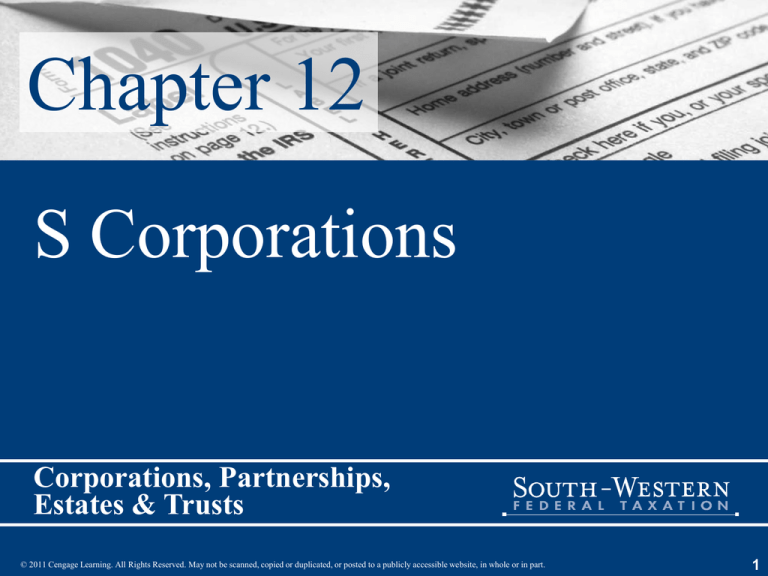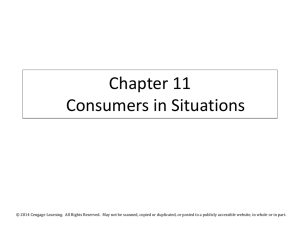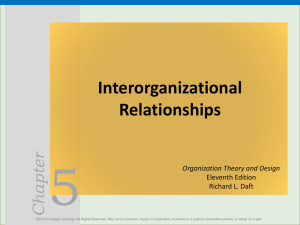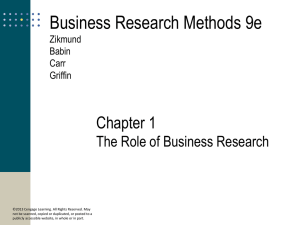
Chapter 12
S Corporations
Corporations, Partnerships,
Estates & Trusts
© 2011 Cengage Learning. All Rights Reserved. May not be scanned, copied or duplicated, or posted to a publicly accessible website, in whole or in part.
1
Subchapter S Issues
(slide 1 of 6)
• S corporations provide many of the benefits of
partnership taxation
– Also gives the owners limited liability protection
from creditors
• S corporation status is obtained through an
election by a qualifying corporation with the
consent of its shareholders
© 2011 Cengage Learning. All Rights Reserved. May not be scanned, copied or duplicated, or posted to a publicly accessible website, in whole or in part.
2
Subchapter S Issues
(slide 2 of 6)
• S corporations are still corporations for legal
purposes
– Owners receive the benefits of limited liability,
ability to raise capital (within limits), etc...
© 2011 Cengage Learning. All Rights Reserved. May not be scanned, copied or duplicated, or posted to a publicly accessible website, in whole or in part.
3
Subchapter S Issues
(slide 3 of 6)
• Taxation resembles partnership taxation
– Certain items (primarily business income and
certain expenses) are accumulated and passed
through to shareholders
– Other items are “separately stated” and each item
is passed through to shareholders
© 2011 Cengage Learning. All Rights Reserved. May not be scanned, copied or duplicated, or posted to a publicly accessible website, in whole or in part.
4
Subchapter S Issues
(slide 4 of 6)
• An S corporation is a reporting (rather than
tax-paying) entity
• Tax liability may still arise at the entity level
for:
– Built-in gains tax, or
– Passive investment income penalty tax
© 2011 Cengage Learning. All Rights Reserved. May not be scanned, copied or duplicated, or posted to a publicly accessible website, in whole or in part.
5
Subchapter S Issues
(slide 5 of 6)
• An S corporation is not subject to the
following taxes:
–
–
–
–
Corporate income tax
Accumulated earnings tax
Personal holding company tax
Corporate alternative minimum tax
© 2011 Cengage Learning. All Rights Reserved. May not be scanned, copied or duplicated, or posted to a publicly accessible website, in whole or in part.
6
Subchapter S Issues
(slide 6 of 6)
• Entity is subject to Subchapter C rules for a
transaction unless Subchapter S provides
alternate rules
© 2011 Cengage Learning. All Rights Reserved. May not be scanned, copied or duplicated, or posted to a publicly accessible website, in whole or in part.
7
When to Elect S Corp Status
• Following factors should be considered:
– If shareholders have high marginal tax rates vs C
corp rates
– If NOLs are anticipated
– If currently C corp, any NOL carryovers from
prior years can’t be used during S corp years
• Still reduces 20 year carryover period
– Character of anticipated flow-through items
© 2011 Cengage Learning. All Rights Reserved. May not be scanned, copied or duplicated, or posted to a publicly accessible website, in whole or in part.
8
S Corp Qualification
Requirements (slide 1 of 3)
• To elect under Subchapter S, a corporation
must meet the following requirements:
– Must be a domestic corporation
– Must not otherwise be “ineligible”
• Ineligible corporations include certain banks, insurance
companies and foreign corporations
• Any domestic corp. that is not an ineligible corp. can be
a qualified Subchapter S Subsidiary (QSSS) if:
– S corp owns 100% of its stock, and
– Elects to treat the subsidiary as a QSSS
© 2011 Cengage Learning. All Rights Reserved. May not be scanned, copied or duplicated, or posted to a publicly accessible website, in whole or in part.
9
S Corp Qualification
Requirements (slide 2 of 3)
• Corporation may have only one class of stock
– Can have stock with differences in voting rights
but not in distribution or liquidation rights
– It is possible for debt to be reclassified as stock
• Results in unexpected loss of S corp status
• Safe harbor provisions mitigate concern over
reclassification of debt
© 2011 Cengage Learning. All Rights Reserved. May not be scanned, copied or duplicated, or posted to a publicly accessible website, in whole or in part.
10
S Corp Qualification
Requirements (slide 3 of 3)
• Must have 100 or less shareholders
– Family members may be treated as one shareholder
• Shareholders can only include individuals, estates,
certain trusts, and certain tax-exempt organizations
– Partnerships, Corps, LLPs, most LLCs and most IRAs
cannot own S corp stock, but S corps can be partners in a
partnership or shareholders in a corporation
• Shareholders cannot include any nonresident aliens
© 2011 Cengage Learning. All Rights Reserved. May not be scanned, copied or duplicated, or posted to a publicly accessible website, in whole or in part.
11
Making the Election
(slide 1 of 3)
• To become an S corp, must make a valid
election that is:
– Filed timely
– All shareholders must consent to the election
© 2011 Cengage Learning. All Rights Reserved. May not be scanned, copied or duplicated, or posted to a publicly accessible website, in whole or in part.
12
Making the Election
(slide 2 of 3)
• To be effective for current year
– Make election by 15th day of third month of
current tax year, or
– File in previous year
© 2011 Cengage Learning. All Rights Reserved. May not be scanned, copied or duplicated, or posted to a publicly accessible website, in whole or in part.
13
Making the Election
(slide 3 of 3)
• Shareholder Consent
– Each shareholder owning stock during election
year must sign consent for election (even if stock
is no longer owned at election date)
– May be able to obtain extension of time for filing
consent from IRS
• Available only if Form 2553 is filed on a timely basis,
reasonable cause is given, and the interests of the
government are not jeopardized
© 2011 Cengage Learning. All Rights Reserved. May not be scanned, copied or duplicated, or posted to a publicly accessible website, in whole or in part.
14
Termination of Election
(slide 1 of 4)
• The S election is lost in any of the following
ways:
1.Shareholders owning a majority of shares
voluntarily revoke the election
– Revocation must be filed by 15th day of third
month to be effective for entire year
– Otherwise, it is effective for first day of following
year, or any other specified future date
© 2011 Cengage Learning. All Rights Reserved. May not be scanned, copied or duplicated, or posted to a publicly accessible website, in whole or in part.
15
Termination of Election
(slide 2 of 4)
2.New shareholder owning > 50% of entity
affirmatively refuses to consent to election
3.Entity no longer qualifies as S corp
– e.g., The entity has > 100 shareholders or a
nonresident alien shareholder, a second class of
stock exists, etc.
– Election is terminated on date disqualification
occurs
© 2011 Cengage Learning. All Rights Reserved. May not be scanned, copied or duplicated, or posted to a publicly accessible website, in whole or in part.
16
Termination of Election
(slide 3 of 4)
4.The corporation does not meet the passive
investment income limitation
– Passive investment income limitation
• If passive income > 25% of gross receipts for 3
consecutive taxable years
– S election is terminated as of the beginning of the fourth year
– Only applies if an S corp. has C corp. E & P
© 2011 Cengage Learning. All Rights Reserved. May not be scanned, copied or duplicated, or posted to a publicly accessible website, in whole or in part.
17
Termination of Election
(slide 4 of 4)
• A new election normally cannot be made
within 5 years after termination of a prior
election
– Five year waiting period is waived if:
• There is a > 50% change in ownership after first year
termination is applicable
• Event causing termination was not reasonably within
control of the S corp or its majority shareholders
© 2011 Cengage Learning. All Rights Reserved. May not be scanned, copied or duplicated, or posted to a publicly accessible website, in whole or in part.
18
Computation of Taxable Income
(slide 1 of 2)
• Determined in a manner similar to partnerships
except
– S corp amortizes organizational costs under the
corporate rules
– S corp must recognize gains (but not losses) on
distributions of appreciated property to
shareholders
© 2011 Cengage Learning. All Rights Reserved. May not be scanned, copied or duplicated, or posted to a publicly accessible website, in whole or in part.
19
Computation of Taxable Income
(slide 2 of 2)
• S corp items are divided into:
– Nonseparately stated income or loss
• Essentially, constitutes Subchapter S ordinary income or
loss
– Separately stated income, losses, deductions and
credits that could affect tax liability of
shareholders in a different manner
• Identical to separately stated items for partnerships
© 2011 Cengage Learning. All Rights Reserved. May not be scanned, copied or duplicated, or posted to a publicly accessible website, in whole or in part.
20
Flow-Through of S Corporation Items
© 2011 Cengage Learning. All Rights Reserved. May not be scanned, copied or duplicated, or posted to a publicly accessible website, in whole or in part.
21
Separately Stated Items
• Examples include:
– Tax-exempt income
– Gains/losses from disposal of business property
and capital assets
– Charitable contributions
– Income/loss from rental of real estate
– Interest, dividend, or royalty income
– Tax preference items
© 2011 Cengage Learning. All Rights Reserved. May not be scanned, copied or duplicated, or posted to a publicly accessible website, in whole or in part.
22
Allocation of Income and Loss
(slide 1 of 2)
• Each shareholder is allocated a pro rata portion
of nonseparately stated income (loss) and all
separately stated items
– If stock holdings change during year, shareholder
is allocated a pro rata share of each item for each
day stock is owned
© 2011 Cengage Learning. All Rights Reserved. May not be scanned, copied or duplicated, or posted to a publicly accessible website, in whole or in part.
23
Allocation of Income and Loss
(slide 2 of 2)
– Short-year election is available if a shareholder’s
interest is completely terminated (through
disposition or death)
• Allows tax year to be treated as two tax years
– Results in interim closing of books on date of termination
– Shareholders report their shares of S corp items as they
occurred during year
© 2011 Cengage Learning. All Rights Reserved. May not be scanned, copied or duplicated, or posted to a publicly accessible website, in whole or in part.
24
S Corporation Distributions
(slide 1 of 7)
• Amount of distribution to shareholder = cash +
FMV of any other property distributed
• Taxation of distribution depends on whether
the S corp has accumulated E&P from C corp
years
© 2011 Cengage Learning. All Rights Reserved. May not be scanned, copied or duplicated, or posted to a publicly accessible website, in whole or in part.
25
S Corporation Distributions
(slide 2 of 7)
• Where no Earnings and Profits exist
• 1. Nontaxable to the extent of adjusted
basis in stock
• 2. Excess treated as gain from the sale
or exchange of property (capital gain
in most cases)
© 2011 Cengage Learning. All Rights Reserved. May not be scanned, copied or duplicated, or posted to a publicly accessible website, in whole or in part.
26
S Corporation Distributions
(slide 3 of 7)
• Where Earnings and Profits exist
–
–
–
–
–
–
1. Tax-free to the extent of accumulated adjustments account*
2. Any PTI from pre-1983 tax years can be distributed tax-free
3. Remaining distribution is ordinary dividend from AEP**
4. Tax-free to extent of Other Adjustments Account
5. Tax-free reduction in basis of stock
6. Excess treated as gain from the sale or exchange of stock (capital
gain in most cases)
– * Once stock basis reaches zero, any distribution from AAA is treated
as a gain from sale or exchange of stock. “Basis” is the maximum taxfree distribution a shareholder can receive.
– ** AAA bypass election is available
© 2011 Cengage Learning. All Rights Reserved. May not be scanned, copied or duplicated, or posted to a publicly accessible website, in whole or in part.
27
S Corporation Distributions
(slide 4 of 7)
• Accumulated Adjustments Account (AAA)
– Represents cumulative total undistributed
nonseparately and separately stated items
– Mechanism to ensure that earnings of an S corp are
taxed to shareholders only once
© 2011 Cengage Learning. All Rights Reserved. May not be scanned, copied or duplicated, or posted to a publicly accessible website, in whole or in part.
28
S Corporation Distributions
(slide 5 of 7)
• Accumulated Adjustments Account (AAA) is
adjusted as follows:
– Increased by:
• Nonseparately computed income and Schedule K items other than
tax-exempt income
• Depletion in excess of basis in property
– Decreased by:
• Negative Schedule K adjustments other than distributions
• Portion of distribution treated as tax-free from AAA (but not below
zero)
© 2011 Cengage Learning. All Rights Reserved. May not be scanned, copied or duplicated, or posted to a publicly accessible website, in whole or in part.
29
S Corporation Distributions
(slide 6 of 7)
• Other issues regarding distributions:
– Distributions of cash during a one-year period
following S election termination receive special
treatment
• Treated as a tax-free recovery of stock basis to the
extent it does not exceed AAA account
• Since only cash distributions receive this special
treatment, the corp should not distribute property during
this postelection termination period
© 2011 Cengage Learning. All Rights Reserved. May not be scanned, copied or duplicated, or posted to a publicly accessible website, in whole or in part.
30
S Corporation Distributions
(slide 7 of 7)
• Other issues regarding distributions:
– If E & P exists, the entity may elect to first
distribute E & P before reducing AAA
• Called an AAA bypass election
© 2011 Cengage Learning. All Rights Reserved. May not be scanned, copied or duplicated, or posted to a publicly accessible website, in whole or in part.
31
Distributions of Property
• If the entity distributes appreciated property
– Gain must be recognized
• Treated as if property sold to shareholder for FMV
• Gain is allocated to shareholders and increases
shareholders’ basis in stock in the entity, before
considering the effect of the distribution
• Basis of asset distributed = FMV
© 2011 Cengage Learning. All Rights Reserved. May not be scanned, copied or duplicated, or posted to a publicly accessible website, in whole or in part.
32
Shareholder’s Basis
(slide 1 of 4)
• Determination of initial basis is similar to that
of basis of stock in C corp
– Depends on manner stock was acquired
• e.g., gift, inheritance, purchase, exchange
– Basis is increased by:
•
•
•
•
•
Stock purchases
Capital contributions
Nonseparately computed income
Separately stated income items
Depletion in excess of basis
© 2011 Cengage Learning. All Rights Reserved. May not be scanned, copied or duplicated, or posted to a publicly accessible website, in whole or in part.
33
Shareholder’s Basis
(slide 2 of 4)
– Basis is decreased by:
• Distributions not reported as income by shareholders (e.g., from
AAA or PTI)
• Nondeductible expenses (e.g., fines, penalties)
• Nonseparately computed loss
• Separately stated loss and deduction items
– Similar to partnership basis rules
• First increase basis by income items
• Then decrease it by distributions and finally losses
– Noncapital, nondeductible expenditures reduce stock basis
before losses or deductible items unless taxpayer elects to
have deductible items pass through before any noncapital,
nondeductible items
© 2011 Cengage Learning. All Rights Reserved. May not be scanned, copied or duplicated, or posted to a publicly accessible website, in whole or in part.
34
Shareholder’s Basis
(slide 3 of 4)
• Shareholder’s basis cannot be negative
– Once basis is reduced to zero, any additional
reductions (losses or deductions, but not
distributions) decrease (but not below zero) basis
in loans made to S corp
– Any excess losses or deductions are suspended
– Once basis of debt is reduced, it is increased by
subsequent net increases from all positive and
negative adjustments
© 2011 Cengage Learning. All Rights Reserved. May not be scanned, copied or duplicated, or posted to a publicly accessible website, in whole or in part.
35
Shareholder’s Basis
(slide 4 of 4)
• Basis rules are similar to partnership rules
except:
– Partner’s basis in partnership interest includes
direct investment plus a ratable share of
partnership liabilities
– Except for loans from a shareholder to the S Corp,
corporate borrowing does not affect shareholder’s
basis
© 2011 Cengage Learning. All Rights Reserved. May not be scanned, copied or duplicated, or posted to a publicly accessible website, in whole or in part.
36
Treatment of Losses
(slide 1 of 2)
Step 1. Allocate total loss to the shareholder on a daily basis,
based upon stock ownership
Step 2. If shareholder’s loss exceeds stock basis, apply any
excess to adjusted basis of indebtedness to the
shareholder. Distributions do not reduce debt basis.
Step 3. Where loss > debt basis, excess is suspended and
carried over to future tax years.
• If the shareholder’s basis is insufficient to allow a full flow
through and there is more than one type of loss, the flowthrough amounts are determined on a pro rata basis
– e.g., The S corp. incurs both a passive loss and a net capital loss in the
same year
© 2011 Cengage Learning. All Rights Reserved. May not be scanned, copied or duplicated, or posted to a publicly accessible website, in whole or in part.
37
Treatment of Losses
(slide 2 of 2)
Step 4. In future tax years, any net increase in basis
adjustment restores debt basis first, up to its original
amount.
Step 5. Once debt basis is restored, remaining net increase is
used to increase stock basis.
Step 6. Suspended loss from a previous year now reduces
stock basis first and debt basis second.
Step 7. If S election terminates, any loss carryover remaining
at the end of the post-termination transition period is
lost forever.
© 2011 Cengage Learning. All Rights Reserved. May not be scanned, copied or duplicated, or posted to a publicly accessible website, in whole or in part.
38
At-Risk Rules
• Generally apply to S corp shareholders
– At-risk amounts include:
• Cash and adjusted basis of property contributed to corp
• Any amount borrowed for use in the activity for which
the shareholder is personally liable
• Net FMV of personal assets that secure nonrecourse
borrowing
– Losses suspended under at-risk rules are carried
forward and are available during post-termination
transition period
© 2011 Cengage Learning. All Rights Reserved. May not be scanned, copied or duplicated, or posted to a publicly accessible website, in whole or in part.
39
Passive Losses and Credits
• An S corp is not directly subject to the passive
loss rules
– If the corporation is involved in rental activities or
shareholders do not materially participate
• Passive losses and credits flow through to shareholders
• Shareholder’s stock basis is reduced even if passive
losses are not currently deductible
© 2011 Cengage Learning. All Rights Reserved. May not be scanned, copied or duplicated, or posted to a publicly accessible website, in whole or in part.
40
Built-in Gains Tax
(slide 1 of 4)
• Generally applies to C corporations converting
to S corp status after 1986
– Corporate-level tax on built-in gain recognized in a
taxable disposition within 10 calendar years after
the effective date of the S corp election
• The 10-year holding period is reduced to 7 years for tax
years beginning in 2009 and 2010
© 2011 Cengage Learning. All Rights Reserved. May not be scanned, copied or duplicated, or posted to a publicly accessible website, in whole or in part.
41
Built-in Gains Tax
(slide 2 of 4)
• Tax base includes unrealized gain on assets
held on date of S corp election
– Highest corporate tax rates apply (currently 35%)
– This gain passes through to shareholders as taxable
gain
• Maximum built-in gain recognized over the
required (7- or 10-year) holding period is
limited to aggregate net built-in gain at time
corp. converted to S status
© 2011 Cengage Learning. All Rights Reserved. May not be scanned, copied or duplicated, or posted to a publicly accessible website, in whole or in part.
42
Built-in Gains Tax
(slide 3 of 4)
• Amount of built-in gain recognized in any year
is limited to an “as if” taxable income,
computed as if the corp were a C corp
– Any gain that escapes taxation under this limit is
carried forward and recognized in future years
• S corp can offset built-in gains with unexpired
NOLs or capital losses from
C corp years
© 2011 Cengage Learning. All Rights Reserved. May not be scanned, copied or duplicated, or posted to a publicly accessible website, in whole or in part.
43
Built-in Gains Tax
(slide 4 of 4)
• LIFO recapture tax
– Any LIFO recapture amount at time of S corp
election is subject to a corporate-level tax
– Taxable LIFO recapture amount = excess of
inventory’s value under FIFO over the LIFO value
– Resulting tax is payable in four annual installments
• First payment is due on or before due date of last C corp
tax return
© 2011 Cengage Learning. All Rights Reserved. May not be scanned, copied or duplicated, or posted to a publicly accessible website, in whole or in part.
44
Computation of Built-in
Gains Tax (slide 1 of 2)
Step 1. Select the smaller of built-in gains or
taxable income.*
Step 2. Deduct unexpired NOLs and capital
losses from C corporation tax years.
Step 3. Multiply the tax base from step 2 by the
top corporate tax rate.
*Any net recognized built-in gain > taxable income is carried
forward to the next year, as long as the next year is within the 10year recognition period.
© 2011 Cengage Learning. All Rights Reserved. May not be scanned, copied or duplicated, or posted to a publicly accessible website, in whole or in part.
45
Computation of Built-in
Gains Tax (slide 2 of 2)
Step 4. Deduct business credit carryforwards and AMT
credit carryovers from a C corporation tax year
from the amount obtained in step 3.
Step 5. The corporation pays any tax resulting from
step 4.
© 2011 Cengage Learning. All Rights Reserved. May not be scanned, copied or duplicated, or posted to a publicly accessible website, in whole or in part.
46
Passive Investment Income Penalty
Tax (slide 1 of 3)
• If an S corp has accumulated E&P (AEP)
from C corp years
– A tax is imposed on excess net passive income
(ENPI) calculated as follows:
Passive investment income
ENPI = > 25% of gross receipts
Passive investment income
for the year
Net passive
× investment
income for
the year
© 2011 Cengage Learning. All Rights Reserved. May not be scanned, copied or duplicated, or posted to a publicly accessible website, in whole or in part.
47
Passive Investment Income Penalty
Tax (slide 2 of 3)
• Passive investment income includes royalties,
rents, dividends, interest, annuities
– Only net gain from disposition of capital assets is
included
• Net passive income is passive income less
directly related deductions
© 2011 Cengage Learning. All Rights Reserved. May not be scanned, copied or duplicated, or posted to a publicly accessible website, in whole or in part.
48
Passive Investment Income Penalty
Tax (slide 3 of 3)
• Excess net passive income cannot exceed C
corp. taxable income before considering any
NOL or other special deductions
• Tax rate applied is the highest corporate tax
rate for the year
© 2011 Cengage Learning. All Rights Reserved. May not be scanned, copied or duplicated, or posted to a publicly accessible website, in whole or in part.
49
If you have any comments or suggestions concerning this
PowerPoint Presentation for South-Western Federal
Taxation, please contact:
Dr. Donald R. Trippeer, CPA
trippedr@oneonta.edu
SUNY Oneonta
© 2011 Cengage Learning. All Rights Reserved. May not be scanned, copied or duplicated, or posted to a publicly accessible website, in whole or in part.
50








